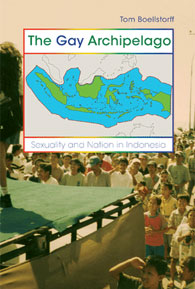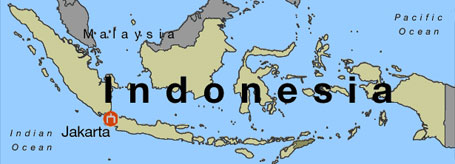Indonesia - like China, India and the United States - is a large, complex country that can be very internally focused. A recent book suggests that it has developed its own terms and understandings on sexual variation - with some parallels to other Southeast Asian countries - but surprising differences. "Gay Indonesia" is a modern idea, but modern in a very Indonesian nationalist context.

Winner of the 2005 Ruth Benedict Prize, Society for Lesbian and Gay Anthropologists, American Anthropological Association; The Gay Archipelago is the first book-length exploration of the lives of gay men in Indonesia, the world's fourth most populous nation and home to more Muslims than any other country.
The picture on the cover of his book The Gay Archipelago shows a transgender waria entertaining families and kids at a government-sponsored Independence Day fair. Where else in the world would the government pay for transgender performers at a national day event? Certainly nowhere I can think of.
Tom did AIDS work. Like the pioneering Western academics on GLBT/Queer stuff, he is both an activist and researcher.
He linked up with Dede Oetomo, and Dede's organisation Gaya Nusantara in eastern Java. Dede has been gay Indonesia for most of us outside the country, and, it seems, for most media inside the country. Who else would you connect with?
Tom's activism, even his AIDS work, should have made him see "gay" and "lesbian" as transnational identities - Western in origin - brought to Indonesia by globalisation. He would then write on these new 'identities' and LGBT identity politics. Or perhaps, wanting to be seen as a more traditional anthropologist in order to get a job, he might seek out some local traditional queer cultural patterns, and write about them.
Instead, in a new twist on Western academic writings on gay issues, he sees "gay" and "lesbi" as national identities in Indonesia - neither linked to local ethnic traditions nor Western models.
How can this be? It has a lot to do with language and media - and the peculiarities of nation-building in Indonesia.
Indonesia may take the prize for cultural diversity. 17,000 islands. 670 ethnic groups. Every religion except Ukrainian Orthodoxy. Islam sailed in with Arab traders, and is, of course, the majority religion. Bali remains Hindu - and there are a variety of religions, local or imported, through the archipelago.
Indonesia only makes sense as the successor to the colonial empire of the Dutch East Indies. Language played a key role in creating a new 'national' identity for Indonesians. The Dutch found that Malay was already established as an inter-island trading language, and renamed it Indonesian. They blessed it as the language of colonial administration. It is not Javanese, the language of the largest ethnic grouping.
Instead Malay, this language of economic globalisation, morphs through from a trade language, to a language of colonial administration, to becoming the nationalist language for the 17,000 islands. And it is neither a colonial language nor the language of the dominant ethnic group.
Links to the Netherlands continued, but that provided no gateway to the world. The Netherlands, once a great colonial power, had returned to being the size of an Indonesian island. Independent Indonesia was an oddity in the world - Muslim, Asian, and nobody spoke English or French. Foreign terms had to come in through translation into Indonesian, not through use in a colonial language.
Beginning around 1970, the terms "gay" and "lesbi" began appearing in Indonesian language magazines and newspapers. At first a few bits and pieces would appear - on Rock Hudson, on the Sydney Mardi Gras, on Indonesian celebrities.
The new words were not referring to waria, the well-known transgender grouping. They were not being used to describe local queer/transgender ethnic traditions - such as bissu among the Bugis or the waroks in Eastern Java. Instead, this was something new.
The words "gay" and "lesbi" were appearing in the Indonesian language and in national print media - two of the key parts of the new Indonesian identity that was being forged. This positioned the terms gay and lesbi as modern and national. They were neither traditional nor seen as foreign imports (though the words clearly had foreign origins).
The strong efforts of the Indonesian state to create a new national culture, superior to the myriad of local cultural groups for which Indonesia is famous, had, it seemed, unintentionally, included homosexuality in what was modern and national.
Naming is a major problem everywhere. Modern patterns of thinking about sexual variation are just over a hundred years old. The word homosexual was only invented in 1869. The terms 'gay' and 'lesbian' are very odd, but better, most people think, than the clinical sounding 'homosexual.'
Aditya Bondyopadhyay, an activist lawyer, explained to some westerners in an international conference in Canada that in India "Gay is having lots of money, going to parties and being able to travel to foreign countries. It's a class identity, not a sexual one." This version of 'gay' is nationally uniform in India. It has no connection to local cultural traditions or to transgender hijras. In Thailand as well, when 'gay' is seen as a category separate from (transgender) kathoey, it refers to middle-class, Westernised Thai men.
These usages from India and Thailand sound like Indonesia. Except that the category in India and Thailand is clearly an import. In Indonesia it is not seen in that way.
One of the striking examples of Indonesia language magazines covering a story of lesbians occurred in 1981. Two women, Jossie and Bonnie, were 'married' in Jakarta in April. The reception was special, "with invitations, guests, fine clothes, and members of both families present." Among the guests were several friends from the police.
The event was featured in two national Indonesian language magazines, Tempo and Liberty. Liberty called the event "unique." It said this was the first event of its kind in Jakarta, maybe in Indonesia, or even in the whole world. Jossie and Bonnie were not copying the West.
Just as stories emerge of women in rural India seeking marriage, no external model was being invoked. The logic is in the relationship, not in local culture, national patterns or globalised models.
I know of no public same-sex wedding in the West in the same period as the wedding of Jossie and Bonnie. Certainly none occurred that had the national impact that their wedding had in Indonesia. That impact would have sent a message to lesbians and gays - 'we exist,' 'you are not alone.'
In the end, Tom Boellstorff argues, "gay and lesbi Indonesians are neither imitating Western homosexualities nor utterly distant from them.
His clinching argument on Indonesian gay and lesbi identities being distinctively Indonesian, and not copies from the West, is the embrace of heterosexual marriage - "normative gay Indonesians marry and normative gay Westerners do not" he says. This, he maintains, is a pattern for gay men across the whole Indonesian archipelago. It is a modern, national, Indonesian idea - not the product of local traditional cultures in specific places like Java or Bali.
Boellstorff says that Indonesian men who already identify as 'gay' choose voluntarily to marry. It is seen as necessary and desirable. Marriage is not simply the result of family pressure (the story from Confucian lands). Instead marriage and children are seen as desirable - and not in conflict with continuing a gay erotic life. Sexual inequality means that heterosexual marriage can be pursued with the wife never knowing (or never asking about) the husband's other life.
The Gay Archipelago: Sexuality and Nation in Indonesia
Tom Boellstorff
Princeton University Press
Read a sample chapter here
http://www.pupress.princeton.edu/chapters/s8103.html
Douglas Sanders is a retired Canadian law professor, living in Bangkok. He can be contacted at sanders_gwb@yahoo.ca.

